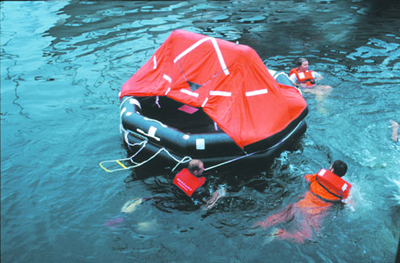The time to think about getting and deploying the life raft is long before it’s ever needed. Being organized before hand and having emergency equipment accessible could save lives.
When discussing an abandon ship scenario with crew, I always designate a specific person to get the life raft and someone else to get the grab bag and the additional items we will want to augment those things. Whether stowed on deck or down below, the life raft should be able to be accessed within 60 seconds.
Prior to departure, I make sure it is on top of sails and other equipment and easily fetched whether it’s in a valise or cannister type of container. When the life raft is brought on deck, it should immediately be tied to the boat in a way that, when the raft is tossed over the side, the tether runs clear without fouling on life lines or other equipment. Life rafts can be blown overboard or taken over the side by a wave, and if the boat is sinking or on fire, the last thing you want to see is the life raft being swept away, untethered to the boat.
Do not deploy from the stern with the intention of pushing the inflated raft overboard. Life rafts are designed to be tossed over the side. After taking up all of the slack in the tether, a quick jerk of that line will initiate the inflation. As the raft is inflated, gas will continue to leak off. The amount of gas in the bottle exceeds the amount needed to fill the raft and valves are designed to allow the excess gas to escape safely.
Grab bags, EPIRB, VHF, spare flares and water should be taken as well as medical kit and other items if at all possible. Life rafts have basic things packed inside, and it’s a good idea to know beforehand what has been packed in your raft. If you or others require medication or want additional things stowed in the raft, you should make those available when the raft is being inspected and re-packed long before it’s ever needed.
When deploying the raft, if possible, bring the life raft alongside so people can step into the raft from the boat, remaining dry in the process. If that is not possible, and people have to approach the raft from the water, it is sometimes advisable to clip your personal safety harness tethers to the life raft tether in order to remain in contact with the raft as you and other swimmers are approaching it. Typically, it is best to have the strongest person enter the raft first so that he or she can help others get into the raft. When everyone is safely in the raft, take an inventory of what you have. Among other things, the raft will have a cutting tool to sever the tether. Life raft tethers are connected with a D ring that will fail by design at about 500 lbs. of pressure, so a sinking boat will not take the raft down with it.
There are numerous videos on YouTube that show how to effectively deploy and board a life raft. However, there are few substitutes for actually doing it. Hands-on Safety at Sea Seminars developed with the support of Cruising Club of America and Storm Trysail Club and provided by U.S. Sailing actually give you the opportunity to practice the skill under knowledgeable supervision in a pool. Whether you’re a cruiser or a racer, it’s worth the time and effort.
Years ago, it became obvious to me that when an emergency strikes, one is either prepared to meet that event and take control of the situation or the situation will control the people affected. While offshore you may never need to actually deploy a life raft, but if you do you will want to be prepared to do it flawlessly. Lives may depend on it. One way or another you should have a plan, practice it, and be able to execute it quickly. What would you do?















